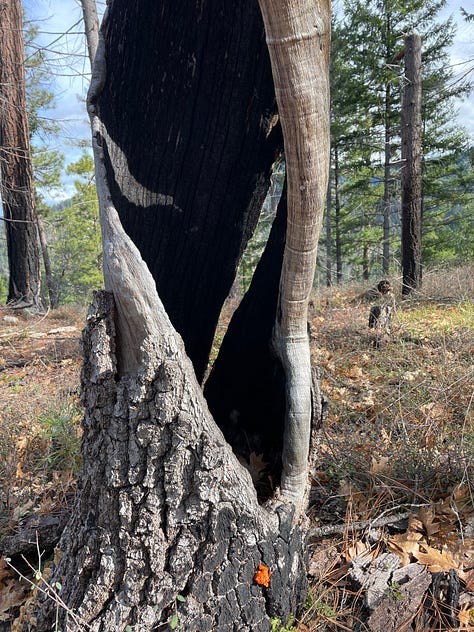Let's talk Tempe* (Tempeh)
Walking in the mountains, appreciating the unsung plant based protein--tempeh, RECIPE for Tempeh Ruebens
There is a peak on a small mountain, I am not sure at what point a hill becomes a mountain, but given our geography there is nothing about this rugged landscape that suggests a hill. It is the only mountain around us that has the archetypal shape a child would draw if drawing a mountain with a rounded top and no snow. It looks as if it stands alone whereas our mountainous region is a series of ridges with crests and peaks. Its name is Little Humpy and the ridge behind it whose peak, at least from our vantage point, towers above it is Humpy Mountain. (Origin and date of this name unknown.)
Humpy and Little Humpy distract me with their presence when I write. I look out the window at them and it seems they peer back at me. They are there, guests at breakfast, lunch and dinner because, from my place at the dining room table, I can also watch their moods. At this moment Humpy and her ridge are shrouded by low clouds that are illuminated by the sun and a bit too bright to look at.


Yesterday Christopher and I walked to the top of Little Humpy. Years ago the first time we stood atop this peak we’d followed a grown-over skidder road up the side until it petered out and we bushwhacked the rest of the way up the steep side. When we got to the top, it felt a little eerie. Maybe that was because at some point a fire had come through leaving burnt-out conifers and oaks in bizarre sculptures or could be it was the bald eagle parent screamed at us, circling, circling, circling.



We walked to the other side of the small peak and there was a road. We laughed and decided to see where it went. It took us right down to the main road. We found this hilarious. Since then we walk up to the top of Little Humpy regularly. It is easy, but still a good, zone 2 workout, and at the top it is otherworldly. And because the placement of the trees is just so we can’t look back on our own home from this peak that is so close.
When we got home I made Tempeh Rueben sandwiches, which I have to say is a nostalgic comfort food from our early days together. Christopher and I became vegetarians in the late 1980s. Funny how back then (EEE writing that I think of being a kid and the old people talking about how much harder their life was “when I was a kid…”) anyhoo, how back in the 80s people who thought about food systems and feeding growing world populations believed tempeh was the protein of the future. Plant centered diets were riding the momentum created by the 1973 oil crisis. In 1977 Robert Rodale wrote, “Before long [tempeh] will be eaten widely and lovingly across this land of ours.” This was the beginning of a media blitz that splashed the benefits of tempeh across the covers of magazines like Rodale’s Prevention, Mother Earth News Magazine, and Organic Gardening. Small-scale tempeh producers started popping up and by the next decade, local natural food stores or coops had these mycelium-wrapped bean cakes in their freezers. Tofu riding a similar wave gained traction, while tempeh did not.
Meet Tempeh
Let’s back up a moment because it hasn’t become ubiquitous for those of you that haven’t met tempeh it is a tasty traditional plant-based protein. Customarily it is made with soybeans but that is changing as it can be made with any legume or grain. For those familiar with koji it is similar in that it is also a fungi-based fermentation–just a different team. People across the planet are using their local ingredients and with this humble mold creating delicious sustainable food.
I have to say I feel like we are still waiting for tempeh to become part of the Western diet. Headlines like this one, The US could soon by tempted by tempeh, have the same we-are on-the-edge-of-something feeling as they did nearly fifty years after Rodale’s prediction. Despite the interest in alt proteins, tempeh is still under-appreciated and under-utilized.
Tempeh is a whole food processed by mycelium – in doing so a food is created that our body knows how to digest and use to nourish our cells. The process increases not only the bioavailability of the protein but also increases nutrients while decreasing the anti-nutrients. Most notably a plant-based source of B vitamins and vitamin K2.
The beauty of fungi-based fermentation, like koji and tempeh, is that this type of fermentation produces enzymes that penetrate the complex carbohydrates of starch, complex compounds of protein, and complex molecules of fat to begin to break them down into simpler molecules–simple sugars, amino acids, and fatty acids. This does two things. It makes the legume or grain more digestible and much more delicious. This is one of the reasons tempeh becomes a healthy plant-based protein that treads lightly on the planet. This type of fermentation also transforms soy. During tempeh production, antinutritional compounds are reduced by at least 65 percent, and in some studies, some of the antinutritional factors were reduced by as much as 90 percent. [[Frias 2017, Paredes-Lopez 1989, Jiménez‐Martínez 2007]]

Have you eaten tempeh?
Some people compare tempeh to tofu in that it is a soybean product that in many ways is a blank slate to any flavor the cook wants to add. However, while tempeh’s flavor profile can be designed by the cook, on its own, it has a toothsome texture and umami, that it brings to the dish. In this way, the flavors are amplified.
I grew up with tempeh in my diet as a young child while we were living on the island of Ambon in Indonesia. I still love tempeh prepared simply. I usually start by placing the cake in a pan with a bit of water and a splash of soy sauce. I cook it for about 5 minutes on each side. This infuses the cake with a light salty umami and in my mind prepares it for frying or adding to a sauce or stir fry. When I want the tempeh to be a bit smoky I will add some liquid smoke. If I am looking for more neutral umami I will boil the tempeh quickly in a bit of broth.
This is exactly how the Tempeh Rueben starts. See the recipe at the end of this missive.
For paid subscribers I’ve created a mini-tempeh-challenge. You will receive 3 posts with some history, fun facts, and most importantly ideas for incorporating tempeh into your diet. The first will land tomorrow.
*The traditional spelling is tempe with angelized spelling adding the ‘h’ for pronunciation.
Down the 🐇 🕳
History of Tempeh and Tempeh Products. This PDF is free from the Soy Info Center rung by Bill Shurtleff and Akiko Aoyagi and is described as by the authors as “the most comprehensive book ever published about the history of tempeh. It has been compiled, one record at a time over a period of 44 years, in an attempt to document the history of this ancient and interesting food.” And at over 1500 pages it is loaded with resources, book reviews, maker stories, and more.
Much more manageable is their seminal book The Book of Tempeh which is full of recipes that incorporate tempeh.
Tempeh: A semicentennial review on its health benefits, fermentation, safety, processing, sustainability, and affordability is a nearly 40-page summary of tempeh’s position in science. If you want to do a deep dive this paper is great as there is so much in one place. It cites studies on the practical nature of processing and food safety as well as nutritional contents and its effect on gut health, brain health, lung health, bone health, obesity, and so on. Cliff notes: There are a lot of potentially positive impacts to our health but in most cases, the studies are small or single and point to more needed.
RECIPE: Tempeh Rueben
This open-faced sandwich incorporates a few traditionally fermented ingredients and is definitely a fusion: tempeh from Indonesia, soy sauce from Japan, sauerkraut from the cold climes of Europe, and the concept of the Reuben sandwich from somewhat disputed origins in the early part of the twentieth century in the USA.
1 (16-ounce/454 g) package tempeh
1/2 cup (119 ml) water
1/4 cup (59 ml) soy sauce
1–2 tablespoons (15–30 ml) avocado oil
1 medium onion, diced
{1/2} cup (230 g) mayonnaise, or vegan mayo
1 tablespoon (15 g) Fermented Horseradish or prepared horseradish
6 pieces Jewish-style caraway-seeded rye bread
2 cups (300 g) sauerkraut, or kimchi for extra kick
2 cups (226 g) grated Swiss cheese, or vegan alternative
1. Preheat the broiler. Set an oven rack in the middle position.
2. Slice the tempeh thinly. Bring the water and soy sauce to a simmer in a skillet and add the tempeh slices. Simmer for 1 to 2 minutes on each side. Remove from the pan and set aside. Rinse the cooking liquid from the pan.
3. Return the pan to the stove and warm the oil over medium heat. Add the tempeh and onion to the pan and sauté until the onions are translucent and the tempeh is lightly browned. Remove from the heat and set aside.
4. Make the sauce by mixing the mayonnaise and horseradish together; slather this on the slices of bread.
5. Put the rye bread, sauce side up, on a baking sheet. Divide the tempeh mixture among the 6 sandwiches. Top each open-faced sandwich with a generous helping of kraut and Swiss cheese.
6. Broil until the cheese is bubbling, about 5 minutes. Serve hot.



usually when i make a reuben i melt the cheese and then take it out of the oven and put the kraut on top. doesn’t heating the sauerkraut kill the probiotic properties?
YUMMY! thank you. looks like you have a whole book about making tempeh and more! will you be updating that anytime soon or should i order it now? i've been wanting to explore this and tofu making...